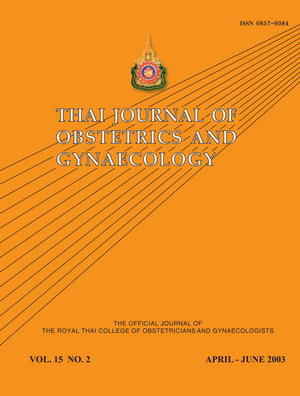Prevalence of Dyspareunia in Healthy Thai Perimenopausal Women
Main Article Content
Abstract
Objective To assess the prevalence of dyspareunia in perimenopausal sample of healthy Thai
women.
Design A cross-sectional descriptive study.
Setting Department of Obstetrics and Gynecology, King Chulalongkorn Memorial Hospital.
Methods 112 Women randomly selected from women between the ages of 40 and 55
presenting for gynecologic care at King Chulalongkorn Memorial Hospital.
Main outcome measurement The prevalence of dyspareunia was reported as percentage with
95 % CI.
Results The prevalence of dyspareunia was 44 %(95 % CI 43.2-44) for the past one year
sexually active women who increased in economic problem, chemical use, duration of marital
status, frequency of intercourse, dysmenorrhea, no contraception and abnormal PAP smear.
Most dyspareunia occurred during intercourse (51%) in the past 3 years, located at vaginal
entrance (55 %), mild degree (89%) and often affected themselves with caused by vaginal
dryness (34%) according to their thought. 21 % of afflicted women had solved it by consulted
physicians.
Conclusions A high prevalence of dyspareunia (44 %) for perimenopausal Thai Women was
observed. The implication for clinical practice was that sexual health or problem should be
inquired asked for a regular part of health care service and the physicians should be
encouraged to initiate discussions about dyspareunia.
women.
Design A cross-sectional descriptive study.
Setting Department of Obstetrics and Gynecology, King Chulalongkorn Memorial Hospital.
Methods 112 Women randomly selected from women between the ages of 40 and 55
presenting for gynecologic care at King Chulalongkorn Memorial Hospital.
Main outcome measurement The prevalence of dyspareunia was reported as percentage with
95 % CI.
Results The prevalence of dyspareunia was 44 %(95 % CI 43.2-44) for the past one year
sexually active women who increased in economic problem, chemical use, duration of marital
status, frequency of intercourse, dysmenorrhea, no contraception and abnormal PAP smear.
Most dyspareunia occurred during intercourse (51%) in the past 3 years, located at vaginal
entrance (55 %), mild degree (89%) and often affected themselves with caused by vaginal
dryness (34%) according to their thought. 21 % of afflicted women had solved it by consulted
physicians.
Conclusions A high prevalence of dyspareunia (44 %) for perimenopausal Thai Women was
observed. The implication for clinical practice was that sexual health or problem should be
inquired asked for a regular part of health care service and the physicians should be
encouraged to initiate discussions about dyspareunia.
Article Details
How to Cite
(1)
Chen, O.; Taneepanichskul, S. Prevalence of Dyspareunia in Healthy Thai Perimenopausal Women. Thai J Obstet Gynaecol 2017, 15, 113-121.
Section
Original Article


